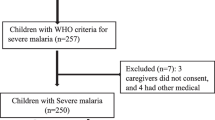Abstract
An interpretation of historical, clinical, and laboratory data was made to identify the correlates of and the diversity between cerebral malaria (CM) and severe malarial anemia (SMA) in a setting of low, seasonal, and unstable malaria transmission in eastern Sudan. Hemoglobin (Hb), random blood glucose (RBG), and anti-MSP antibodies were measured. Results showed that SMA and CM were significantly different with regard to age, malaria history, fever duration, convulsions, and hepatosplenomegaly. The MSP Ab response was inversely correlated with the number of previous malaria episodes but not with fever duration in the current attack. The spleen size was significantly inversely correlated with Hb level while hepatomegaly was significantly associated with low RBG. Furthermore, two malaria patients presented with neuropsychiatric upset. Finally, the correlates of SMA and CM fit perfectly with an adopted severity numeric scoring.

Similar content being viewed by others
Explore related subjects
Discover the latest articles and news from researchers in related subjects, suggested using machine learning.References
WHO (2000) Severe falciparum malaria. Communicable Diseases Cluster. Trans R Soc Trop Med Hyg 94:S1–S90
Molyneux ME (1989) Malaria—clinical features in children. J R Soc Med 82:35–38
Bruneel F, Hocqueloux L, Alberti C, Wolff M, Chevret S, Bédos JP, Durand R, Le Bras J, Régnier B, Vachon F (2003) The clinical spectrum of severe imported falciparum malaria in the intensive care unit: report of 188 cases in adults. Am J Respir Crit Care Med 167:684–689
Giha HA, Elghazali G, A-Elgadir TM, A-Elbasit IE, Eltahir EM, Baraka OZ, Khier MM, Adam I, Troye-Blomberg M, Theander TG, Elbashir MI (2005) Clinical pattern of severe Plasmodium falciparum malaria in Sudan in an area characterized by seasonal and unstable malaria transmission. Trans R Soc Trop Med Hyg 99:243–251
Trampuz A, Jereb M, Muzlovic I, Prabhu RM (2003) Clinical review: severe malaria. Crit Care 7:315–323
Hamad AA, Nugud Ael H, Arnot DE, Giha HA, Abdel-Muhsin AM, Satti GM, Theander TG, Creasey AM, Babiker HA, Elnaiem DE (2002) A marked seasonality of malaria transmission in two rural sites in eastern Sudan. Acta Trop 83:71–82
Cavanagh DR, Elhassan IM, Roper C, Robinson VJ, Giha H, Holder AA, Hviid L, Theander TG, Arnot DE, McBride JS (1998) A longitudinal study of type-specific antibody responses to Plasmodium falciparum merozoite surface protein-1 in an area of unstable malaria in Sudan. J Immunol 161:347–359
Gupta S, Snow RW, Donnelly CA, Marsh K, Newbold C (1999) Immunity to non-cerebral severe malaria is acquired after one or two infections. Nat Med 5:340–343
Reyburn H, Mbatia R, Drakeley C, Bruce J, Carneiro I, Olomi R, Cox J, Nkya WM, Lemnge M, Greenwood BM, Riley EM (2005) Association of transmission intensity and age with clinical manifestations and case fatality of severe Plasmodium falciparum malaria. JAMA 293:1461–1470
Legrand E, Volney B, Lavergne A, Tournegros C, Florent L, Accrombessi D, Guillotte M, Mercereau-Puijalon O, Esterre P (2005) Molecular analysis of two local falciparum malaria outbreaks on the French Guiana coast confirms the msp1 B-K1/varD genotype association with severe malaria. Malar J 21(4):26
van Thien H, Ackermans MT, Dekker E, Thanh Chien VO, Le T, Endert E, Kager PA, Romijn JA, Sauerwein HP (2001) Glucose production and gluconeogenesis in adults with cerebral malaria. QJM 94:709–715
Jakeman GN, Saul A, Hogarth WL, Collins WE (1999) Anaemia of acute malaria infections in non-immune patients primarily results from destruction of uninfected erythrocytes. Parasitology 119:127–133
White NJ, Ho M (1992) The pathophysiology of malaria. Adv Parasitol 31:83–173
Weiss MG (1985) The interrelationship of tropical disease and mental disorder: conceptual framework and literature review (part I—malaria). Cult Med Psychiatry 9:121–200
Mishra SK, Panigrahi P, Mishra R, Mohanty S (2007) Prediction of outcome in adults with severe falciparum malaria: a new scoring system. Malar J 6:24
Author information
Authors and Affiliations
Corresponding author
Additional information
Hayder A. Giha and Gehad Elghazali contributed equally to this paper.
Rights and permissions
About this article
Cite this article
Giha, H.A., Elghazali, G., A-Elgadir, T.M.E. et al. Severe malaria in an unstable setting: clinical and laboratory correlates of cerebral malaria and severe malarial anemia and a paradigm for a simplified severity scoring. Eur J Clin Microbiol Infect Dis 28, 661–665 (2009). https://doi.org/10.1007/s10096-008-0665-5
Received:
Accepted:
Published:
Issue Date:
DOI: https://doi.org/10.1007/s10096-008-0665-5




